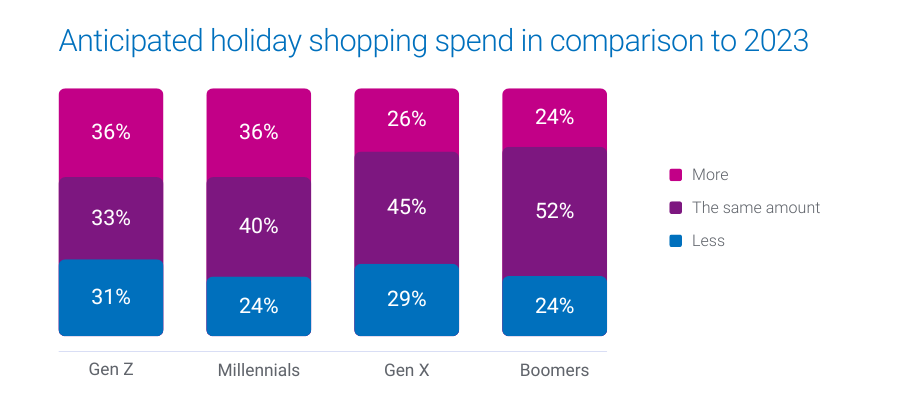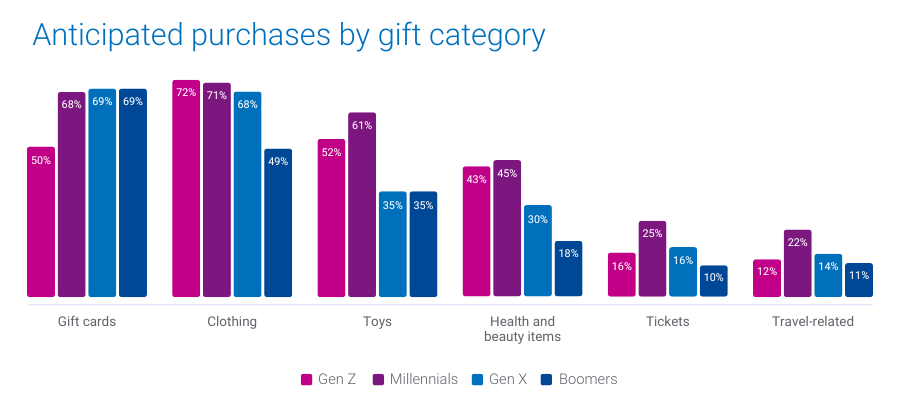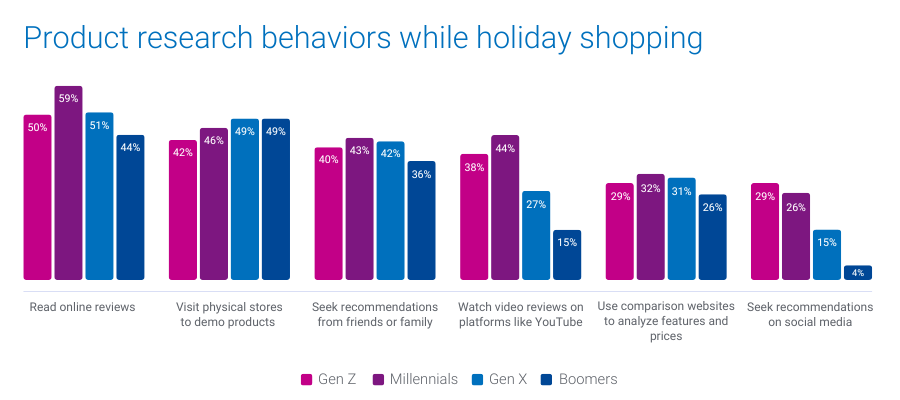
The holiday season is almost here, and knowing how each generation plans to shop can give your holiday advertising campaigns the edge you need. Our recent survey of 1,000 U.S. consumers reveals 2024 holiday shopping trends for each generation and key insights into their anticipated spending levels, preferred shopping categories, and how they look for gift ideas.
In this blog post, we’ll explore three 2024 holiday shopping trends across generations:
- Projected consumer spending
- Top categories on shoppers’ lists
- Preferred channels for researching gifts
1. Projected consumer spending
Over 1 in 3 Gen Z and Millennials are gearing up to increase their holiday budgets this year, while Gen X and Boomers are likelier to stick to last year’s budget.
- 36% of Millennials and Gen Z plan to spend more this holiday season
- 45% of Gen X and 52% of Boomers expect their spending to remain consistent with last year

What this means for marketers
These insights highlight the importance of tailoring your messaging. For Gen Z and Millennials, emphasize value and unique offerings that justify increased spending. For Gen X and Boomers, focus on trust and reliability, reinforcing their confidence in your brand.
How Experian can help you target these audiences
Experian’s custom and syndicated audience segments, including Holiday Shopper High Spenders and Holiday Shopper Moderate Spenders, enable you to connect with these diverse consumer groups. Our audiences are available on-the-shelf of leading ad platforms to help you reach people across social, TV, and mobile.
The election effect
U.S. holiday retail sales saw 4.1% YoY growth in 2016 and 8.3% YoY growth in 2020 following presidential elections. There’s a chance that holiday spending increases after the 2024 election, regardless of the outcome. Experian has 240+ politically relevant audiences that you can activate across major ad platforms ahead of the upcoming election.
2. Top categories on shoppers’ lists
Different generations have distinct preferences when it comes to what they plan to buy. Gift cards top the list for Gen X and Boomers, while Gen Z leans toward clothing. Millennials are looking to splurge on toys, electronics, and experiences.
- 69% of Boomers and Gen X plan to purchase gift cards
- 72% of Gen Z will buy clothing
- 45% of Millennials will buy health and beauty items
- 25% of Millennials will buy tickets and 22% of Millennials will buy experiences

What this means for marketers
Align your product offerings and promotions with each generation’s preferences to capture their attention. For example, highlighting versatile gift cards may resonate more with older generations, while showcasing trendy apparel and tech gadgets will appeal to younger consumers.
How Experian can help you target these shoppers
We offer audience segments like Holiday Shoppers: Apparel, Cosmetics & Beauty Spenders, and Toys Shoppers that you can activate to connect with consumers primed to purchase in these categories.
We recently released 19 new holiday shopping audiences we recommend targeting to drive engagement and conversions. Download our audience recommendations here.
3. Preferred channels for researching gift ideas
When it comes to finding the perfect gifts, Gen Z turns to social media, while Millennials prefer online reviews and video content. Boomers and Gen X are more inclined to visit physical stores for hands-on product evaluations.
- 29% of Gen Z and 26% of Millennials will look for gift ideas on social media
- 44% of Millennials will rely on video reviews and product demos on platforms like YouTube
- 49% of Gen X and Boomers plan to visit physical stores to evaluate products in person

What this means for marketers
Understanding where each generation looks for inspiration can guide your content and ad placement strategy. To engage Gen Z, focus on social media campaigns and influencer partnerships. For Millennials, consider investing in video content and reviews. For older generations, ensure your in-store experience is optimized to convert browsing into purchases.
How Experian can help you engage these shoppers
Our TrueTouchTM audiences can help you pair the perfect messaging styles with the right channels and calls to action. Our Social media channel and content engagement audiences can help you reach Gen Z who are likely to be active users on major social platforms and are Black Friday shoppers. For a full list of Experian’s syndicated audiences and activation destinations, download our syndicated audiences guide.
Download our report for five 2024 holiday shopping trends by generation
Understanding 2024 holiday shopping trends by generation can help you tailor your targeting, messaging, media planning, and creative based on the generation you’re targeting.
In addition to the insights covered here, download our 2024 Holiday spending trends and insights report to learn:
- When consumers plan to shop (hint: they’re already shopping)
- Where they plan to shop (online vs. in-store)
Download our full report to access all five of our predictions by generation, so you can address the diverse needs of this year’s holiday shoppers.
When you work with Experian for your holiday shopping campaigns, you’re getting:
- Accurate consumer insights: Better understand your customers’ behavioral and demographic attributes with our #1 ranked data covering the full U.S. population.
- Signal-agnostic identity solutions: Our deep understanding of people in the offline and digital worlds provides you with a persistent linkage of personally identifiable information (PII) data and digital IDs, ensuring you accurate cross-device targeting, addressability and measurement.
- Secure connectivity: Bring data and identity to life in a way that meets your needs by securely sharing data between partners, utilizing the integrations we have across the ecosystem, and using our marketing data in flexible ways.
Make the most of this holiday shopping season with Experian. Contact us today to get started.
Source
Online survey conducted in June, 2024 among n=1,000 U.S. adults 18+. Sample balanced to look like the general population on key demographics (age, gender, household income, ethnicity, and region).
Latest posts

The annual back-to-school season is in high gear and Moms are preparing lists and sizing up their children’s clothing and school-related merchandise needs. It’s an important time of year for retailers, as apparel, shoes, electronics, furniture, computers, backpacks and school supplies will account for the bulk of consumer spending during the back-to-school shopping season. Many marketers have historically grouped the back-to-school audience into one collective segment of households with school-age children. This leaves money on the table because there are better ways to target Moms with kids when developing a back-to-school promotional strategy. Just like the inventory of new clothes and notebooks that retailers have neatly arranged on store shelves, families with school-age children come in an assortment of sizes, shapes and colors. What is the most effective way to segment the back to school audience? This begs the question “” Marketers can always turn to basic data elements for segmentation. These include age and gender of children, number of children in the household, parent’s age, household income, and the full spectrum of school classifications (preschool, elementary school, middle school, junior high school, high school, etc.). Though a more powerful approach would be to utilize a segmentation methodology that recognizes the lifestyle and behavioral differences among households that are most likely to contain school-age kids. Here are three snapshots of family-oriented, children-centric market segments that are highly likely to be responsive to a wide variety of back to school promotional offers. All three segments have been selected from Experian’s Mosaic lifestyle segmentation solution. Babies and Bliss Description: Babies and Bliss represent the premier lifestyle for large families in America. With a majority of households containing at least five people, this segment is a haven for large broods living in new suburban subdivisions. Parents in this segment tend to be in their 30s and 40s. There is a wide range of kids in these households, from preschoolers up to those in high school. There is also money in this segment, reflecting the high educations and low six-figure incomes that come from dual earners employed in professional and technical occupations. Some key traits of Babies and Bliss households include upscale tastes, large families, well-educated, conservative views, financially-savvy, convenience, and power shopping. Implications: Given their large families, it's not surprising that Moms from Babies and Bliss households are value-conscious shoppers who seek appealing deals for quality merchandise. They carry coupons, like to comparison shop when buying expensive items and head to the clearance rack first whenever they buy clothes, which tend to be conservative in style. In the mall, these Moms follow their children's lead but also remain very open to consider generic store brands rather than high-priced name brands. They like to shop (it's practically a sport) and are happy to open their wallets at department stores, specialty shops, catalogs and online sites. They especially pride themselves in being very Internet-literate. With their jobs, kids and errands, they appreciate the convenience of shopping online and are receptive to email ads, sponsored Websites and Web page links. Families Matter Most Description: A fast-growing segment, Families Matter Most consists of young, middle-class families in suburban locations leading active, family-focused lives. Nine out of ten households have kids (nearly two-thirds have multiple kids). These young, middle-class families have settled into a landscape of recently built subdivisions. Many adult household members are urban exiles who've sought a suburban setting with room for kids to grow. They are proud of their new homes, schools and shopping centers, where they can find everything they need just a short drive away. Families Matter Most distinguish themselves by having adopted attitudes and routines to help them effectively juggle the responsibilities of work and child-rearing. Some key traits of Families Matter Most households include sprawling families, family values, casual perspectives, price-sensitivity, credit revolvers, conformists and risk avoidance. Implications: Families Matter Most are casual in their attitude except when it comes to their children. They take their role as parents very seriously, which they describe in conservative terms. They avoid risks and feel little need to make a statement with their possessions. As shoppers, Moms from Families Matter Most households are price-sensitive consumers who look for discount stores that offer durable and comfortable fashion. They are worried about spending money impulsively and try to be informed consumers. Most are happy to wear last year's fashions and they tend to zero in on a few stores that carry the affordable brands they prefer. With their growing families they shop most often at discount and mid-market national chains including Target, Walmart, Kohl's, Toys R Us and Old Navy. Cul de Sac Diversity Description: Cul de Sac Diversity consists of ethnically diverse, middle-aged couples with school-aged children. This segment has an above-average concentration of Hispanic and Asian household members. Nearly one-third of Cul de Sac Diversity adult members are foreign-born. They are three times more likely to be bilingual compared to U.S. adults overall. These upper-middle-class households are well on their way to achieving the American dream. They believe in home and family, but also recognize the need to work to get ahead. They look at their work as a career, not a paycheck, and are willing to give up family time in exchange for the opportunity to advance in their careers. Some key traits of Cul de Sac Diversity households include ethnically diverse, bilingual, mainstream mindset, community-minded, tolerant and career-focused. Implications: Moms from Cul de Sac Diversity households like to shop with friends and family members in order to get everyone's opinions on potential purchases. As consumers, they often seek status and recognition through their possessions. They are attracted to designer labels and sometimes spend more on clothes than they can truly afford. They like going to mainstream retailers to shop for their children including Kohl's and Macy's as well as sporting goods chains such as Dick's Sporting Goods and Sports Authority. They are only moderately receptive to online advertising. Deploying a back to school marketing strategy that treats all households with school-age children as one undifferentiated market is like creating a basic lesson plan and applying it to all grade levels of a one-room schoolhouse. Instead, marketers are encouraged to study their target audience more closely. With key insights in hand, they will have acquired the necessary prerequisites for graduating to a strategy that acknowledges the shopping characteristics and needs of a diverse and potentially lucrative audience of back-to-school Moms and their children.

Segmentation Layering For many marketers, segmentation is like breathing – it comes naturally and is a part of everything they do. To better connect with your target audience, use a good segmentation system with multiple layers that provides a breakdown of essential information while tying in lifestyle and transactional data. Consider marketing to parents. The most basic information includes demographics such as age, income, presence of children, etc. Add to that lifestyle information – the family has two working parents who rely heavily on the Internet for research and purchase convenience. The transactional data can really set apart where a parent falls on the parenting lifecycle. For example, is the parent still purchasing diapers and feeding supplies for their infant or bedding, towels and a coffee maker that might indicate their “baby” is headed to college? Both parents may look similar when comparing demographic and lifestyle information but the transactional data differentiates their needs. According to Experian Marketing Services: Parents use the Internet far more than the average American Moms are 34% more likely to buy products online and 33% more likely to participate in a blog than the average adult. "Marketers are targeting more carefully based on both the parents' life stage and consumer behavior,” says Jan Jindra, senior product market manager at Experian Marketing Services. “Younger parents, and those of smaller children, have different information needs than parents of older or college-age children. It's not only the life stage they're in, but the lifestyle," Jindra says. Read the full article and check out the latest in marketing to parents in DMNews: http://www.dmnews.com/household-brands-observe-parents-needs-in-defining-segmentation-tactics/article/205902/.

Retailers are realizing that a large percentage of their revenue stream comes from existing customers, which is why so many starting to invest in customer loyalty programs. A recent Experian QAS study revealed that 63 percent of organizations track the lifetime value of each customer, and 72 percent see that value increasing over time. Loyalty programs are an effort to promote up-sell and cross-sell opportunities to make sure customers continue to buy throughout their lifecycle. However, simply investing in a loyalty program isn’t enough; retailers need to be sure that the contact data in those programs is accurate. At the most basic level, marketing offers can only reach customers when the contact information is accurate, but contact data also affects a retailer’s ability to analyze their current customer base to allow better segmentation and intelligence. To ensure data accuracy, make sure to put verification tools in place at each point of capture so that contact data is valid and complete as it is being entered. Then make sure you are updating data on a consistent basis and that it is being put into one centralized database for better analysis. Learn more about the author, Erin Haselkorn